Ireland

 Growing up with the last name of Spencer, I have always been aware that I was related to the Spencers in England, including Princess Diana, her sons and grandchildren, as well as Winston Spencer Churchill. Of course, these relationships were on the Spencer side of my family, but recently, I have been stumbling upon, or in reality, tripping over royalty of the Pattan side of my family, as well as more direct ties to the English throne on the Spencer side of the family.
Growing up with the last name of Spencer, I have always been aware that I was related to the Spencers in England, including Princess Diana, her sons and grandchildren, as well as Winston Spencer Churchill. Of course, these relationships were on the Spencer side of my family, but recently, I have been stumbling upon, or in reality, tripping over royalty of the Pattan side of my family, as well as more direct ties to the English throne on the Spencer side of the family.
When I spoke to my Aunt Sandy Pattan about the king connection of the Pattan side, she said that she knew of Queen Victoria, who I had not found yet, by the way, but she was unaware of the kings in the family line, and was very surprised about where they came from…not the family background, but rather the global locations. The first one to show up was King Charles II of England, who is my 1st cousin 11 times removed. King Charles was actually the king of Scotland from January 30, 1649 to September 3, 1651, and then king of England, Scotland, and Ireland from May 29, 1660 until his death on February 6, 1685 from a stroke.
The next king to show up was King Frederick I of Prussia, who was my 2nd cousin 10 times removed. He was king from January 18, 1701 until his death on February 25, 1713 in Berlin. Next came King Louis XIV of France, who is my 3rd cousin 10 times removed. He was king from May 14, 1643 until his death on September 1, 1715 of gangrene. The next king to show up was King Frederick William II of Prussia, who is my 4th cousin 7 times removed. He was king from August 17, 1786 until his passing on November 16, 1797 in Potsdam, Germany. 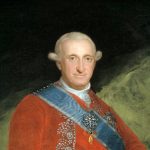

 The next king was King Charles IV of Spain, who is my 4th cousin 6 times removed. He was king from December 14, 1788 to March 18, 1808. He did not end his reign upon his death, but rather, riots and popular revolt at the winter palace in Aranjuez, forced him to abdicate to his son, Ferdinand VII. He died on January 20, 1819 in Palazzo Barberini, Rome.
The next king was King Charles IV of Spain, who is my 4th cousin 6 times removed. He was king from December 14, 1788 to March 18, 1808. He did not end his reign upon his death, but rather, riots and popular revolt at the winter palace in Aranjuez, forced him to abdicate to his son, Ferdinand VII. He died on January 20, 1819 in Palazzo Barberini, Rome.
The next king to present himself was King Louis XVI of France, who is of course, related to an earlier king. King Louis XVI is my 4th cousin 6 times removed. He was king of France from May 10, 1774 to September 4, 1792, and oddly King of the French from September 4, 1791 to September 21, 1792. On August 13, 1792, an angry mob tried to kill the queen, thinking that she was too frivolous, but decided to go after the king instead. He tried to flee with his family to Paris, but was captured on August 13, 1792, and imprisoned. His titles were stripped from him on September 21, 1792. He died on January 21, 1793 by execution on the guillotine at just 38 years of age. Finally came Charles VI, Holy Roman Emperor, who is my 4th cousin 9 times removed. He was emperor from October 12, 1711 until his death on October 20, 1740, following a hunting trip on which he consumed a meal of poisonous death cap mushrooms.
I thought that finding out that my mom’s family was related to so many kings, and even an emperor, was 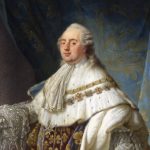
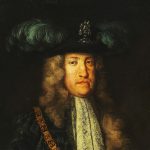 going to be the most shocking thing, but for me, I think the most shocking thing was the way that some of these kings died. It showed me that the times that these kings lived in were not only dangerous in that many of the health issues that are curable now, weren’t back then. But more shocking for me was that fact that kings were sometimes no more safe than anyone else. To accidently eat poison mushrooms would be a horrible death, and I can’t imagine going through that, but to be executed by guillotine is one of the most gruesome things I can think of, and that was not totally uncommon back then.
going to be the most shocking thing, but for me, I think the most shocking thing was the way that some of these kings died. It showed me that the times that these kings lived in were not only dangerous in that many of the health issues that are curable now, weren’t back then. But more shocking for me was that fact that kings were sometimes no more safe than anyone else. To accidently eat poison mushrooms would be a horrible death, and I can’t imagine going through that, but to be executed by guillotine is one of the most gruesome things I can think of, and that was not totally uncommon back then.

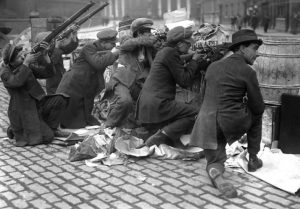 Because my family has some history in England and Ireland, the history of that area holds an interest for me. Through my DNA, I have found out that much of the family I previously thought of as English, actually originated in France. Nevertheless, they spent the majority of the centuries in England and Ireland. That said, the feuds between the two nations have been as interesting to me as the Revolutionary War. I suppose that when a nation turns an area into a territory, and then that area decides to become it’s own nation, there can be a bit of an uproar…to put it mildly. The parent nation is usually very much against the independence of the child nation…for lack of a better word.
Because my family has some history in England and Ireland, the history of that area holds an interest for me. Through my DNA, I have found out that much of the family I previously thought of as English, actually originated in France. Nevertheless, they spent the majority of the centuries in England and Ireland. That said, the feuds between the two nations have been as interesting to me as the Revolutionary War. I suppose that when a nation turns an area into a territory, and then that area decides to become it’s own nation, there can be a bit of an uproar…to put it mildly. The parent nation is usually very much against the independence of the child nation…for lack of a better word.
It was on April 24, 1916…Easter Monday, that the Irish Republican Brotherhood, which was a secret organization of Irish nationalists led by Patrick Pearse, launched the so-called Easter Rebellion in Dublin. It was an armed uprising against British rule. The Brotherhood was assisted by militant Irish socialists under James Connolly. Pearse and his fellow Republicans rioted and attacked British provincial government headquarters across Dublin and seized the Irish capital’s General Post Office. After their quick initial success, they proclaimed the independence of Ireland, and by morning they controlled much of the city of Dublin. They were fighting against the repressive government of the United Kingdom that they had been under for centuries. Their hopes of freedom were dashed later the next day when the British authorities launched a counterattack. By April 29th, it was all over. The uprising had been crushed. Nevertheless, the Easter Rebellion is considered a significant marker on the road to establishing an independent Irish republic.
Following the uprising, Pearse and 14 other nationalist leaders were executed for their participation, but they were held up as martyrs by many in Ireland. There was a lot of anger among most Irish people for the British, who had enacted a series of harsh anti-Catholic restrictions, the Penal Laws, in the 18th century, and then let 1.5 million Irish starve during the Potato Famine of 1845-1848. Armed protest continued after the Easter Rebellion and in 1921, 26 of Ireland’s 32 counties won independence with the declaration of the Irish Free State. The Free State became an independent republic in 1949. However, six northeastern counties of the Emerald Isle remained part of the United Kingdom. This prompted some nationalists to reorganize themselves into the Irish Republican Army (IRA) to continue their struggle for full Irish independence.
In the late 1960s, spurred on in part by the United States civil rights movement, Catholics in Northern Ireland, who had long been discriminated against by British policies that favored Irish Protestants, advocated for justice. Riots broke out between Catholics and Protestants in the region and the violence escalated as the pro-Catholic IRA battled British troops. Most people have heard about this struggle over the years. An ongoing series of terrorist bombings and attacks ensued in a drawn-out conflict that came to be known as “The Troubles.” Peace talks 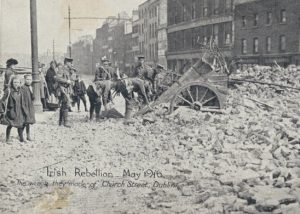
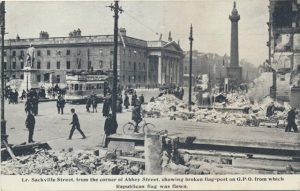 eventually took place throughout the mid to late 1990s, but a permanent end to the violence remained elusive, until July 2005, when IRA finally announced that its members would give up all their weapons and would pursue the group’s objectives solely through peaceful means. By the fall of 2006, the Independent Monitoring Commission reported that the IRA’s military campaign to end British rule was over.
eventually took place throughout the mid to late 1990s, but a permanent end to the violence remained elusive, until July 2005, when IRA finally announced that its members would give up all their weapons and would pursue the group’s objectives solely through peaceful means. By the fall of 2006, the Independent Monitoring Commission reported that the IRA’s military campaign to end British rule was over.
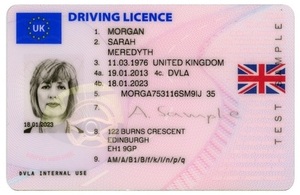 Most people in the United States consider driving a car a right, but in reality it is a privilege, and must be earned. At 15 a child may obtain a permit to drive with a licensed driver by taking a written exam. Then in a year, or at age 16, they have to take a written and driving test to get a license. The driving test can be waived if they have completed driver’s education. The exams are pretty basic, and in this country, most people pass the test on the first try, and if not on the first try, most pass on the second try. The first driving test was administered in 1899 Chicago and New York City. Massachusetts and Missouri were the first US states to require a license for driving a motor vehicle in 1903. Pennsylvania’s 1909 licensing laws were the first to give an age restriction “18 years of age” and the first state to allow 16 year olds to drive, if they were accompanied by a licensed driver, was Connecticut in 1921. I’m sure that prior to these times most people didn’t have one of the new fangled automobiles, so a license was not needed.
Most people in the United States consider driving a car a right, but in reality it is a privilege, and must be earned. At 15 a child may obtain a permit to drive with a licensed driver by taking a written exam. Then in a year, or at age 16, they have to take a written and driving test to get a license. The driving test can be waived if they have completed driver’s education. The exams are pretty basic, and in this country, most people pass the test on the first try, and if not on the first try, most pass on the second try. The first driving test was administered in 1899 Chicago and New York City. Massachusetts and Missouri were the first US states to require a license for driving a motor vehicle in 1903. Pennsylvania’s 1909 licensing laws were the first to give an age restriction “18 years of age” and the first state to allow 16 year olds to drive, if they were accompanied by a licensed driver, was Connecticut in 1921. I’m sure that prior to these times most people didn’t have one of the new fangled automobiles, so a license was not needed.
The United Kingdom made the move to require testing on March 24, 1934, and the requirements were a little different than in the United States. The test must be taken in order to receive a full license, and also to add full entitlements to an existing license. The test varies, depending on the class of vehicle that is to be driven, and is administered by the Driver and Vehicle Standards Agency or DVSA, in Great Britain and the Driver and Vehicle Agency, or DVA in Ireland. Those parts of the program seem to be just like here in the United States, but from there on out, there is a pretty big difference. In the United Kingdom, the minimum age at which one can take a driving test is currently 16 for mopeds and 17 for cars, with an exception allowed at 16 for those on the higher/enhanced rate of the mobility component. In addition to a driving licence, a CBT certificate may be required before a moped or motorcycle is ridden.
In Great Britain around 1.6 million people take the practical car test per year. Approximately 43% of those who take it pass the test, and the theory test has a pass rate of about 51.6%. Now I don’t know what you think, but I think the kids in this country would be pretty upset if only half of those who took the test got to actually drive  legally. Then again, maybe kids would study harder for the test in that case. I can’t tell you how many times I have heard a kid say, “It’s all common sense.” My thought is, “What wealth of knowledge about driving a car is a 15 year old, who has never driven one, going to have.” The answer is obvious…to the parents anyway. If they don’t study, they will likely not pass, but what of the people of Great Britain and Ireland. They know the test is difficult. My guess is that they do study, but that the test is a much more advanced version than those in the United States. Maybe it’s because they want it to be more than just common sense. I’m not saying our tests are too easy…but it’s something to consider when you look at the statistics.
legally. Then again, maybe kids would study harder for the test in that case. I can’t tell you how many times I have heard a kid say, “It’s all common sense.” My thought is, “What wealth of knowledge about driving a car is a 15 year old, who has never driven one, going to have.” The answer is obvious…to the parents anyway. If they don’t study, they will likely not pass, but what of the people of Great Britain and Ireland. They know the test is difficult. My guess is that they do study, but that the test is a much more advanced version than those in the United States. Maybe it’s because they want it to be more than just common sense. I’m not saying our tests are too easy…but it’s something to consider when you look at the statistics.
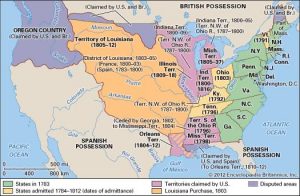 From the time the United States first declared their independence, there was a dispute over the border between the United States and its northern neighbor, Canada. In 1818, the situation finally got to a point whereby a final decision had to be made. It was determined that a convention needed to be held to handle the dispute. The convention, known as the London Convention, Anglo-American Convention of 1818, Convention of 1818, or simply the Treaty of 1818, was to discuss fisheries, boundary and the restoration of slaves between the United States of America and the United Kingdom of Great Britain and Ireland. The Treaty of 1818 was signed during the presidency of James Monroe, and it resolved the boundary between the United States and Canada, then owned by the United Kingdom, once and for all. The treaty allowed for joint occupation and settlement of the Oregon Country, known to the British and in Canadian history as the Columbia District of the Hudson’s Bay Company, and also took in New Caledonia, near Australia.
From the time the United States first declared their independence, there was a dispute over the border between the United States and its northern neighbor, Canada. In 1818, the situation finally got to a point whereby a final decision had to be made. It was determined that a convention needed to be held to handle the dispute. The convention, known as the London Convention, Anglo-American Convention of 1818, Convention of 1818, or simply the Treaty of 1818, was to discuss fisheries, boundary and the restoration of slaves between the United States of America and the United Kingdom of Great Britain and Ireland. The Treaty of 1818 was signed during the presidency of James Monroe, and it resolved the boundary between the United States and Canada, then owned by the United Kingdom, once and for all. The treaty allowed for joint occupation and settlement of the Oregon Country, known to the British and in Canadian history as the Columbia District of the Hudson’s Bay Company, and also took in New Caledonia, near Australia.
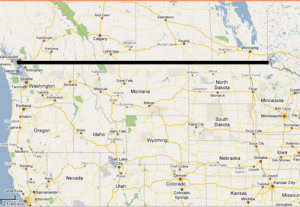
It was ultimately decided that the boundary line should be a straight one, because it would be easier to survey. The prior boundaries were based on watersheds, and were difficult to survey. The treaty marked both the United Kingdom’s last permanent major loss of territory in what is now the Continental United States and the United States’ only permanent significant cession of North American territory to a foreign power. Britain ceded all of Rupert’s Land south of the 49th parallel and west to the Rocky Mountains, including all of the Red River Colony south of that latitude, while the United States ceded the northernmost tip of the territory of Louisiana above the 49th parallel.
 Of course, the prior border from the Great Lakes to the east coast, was already established, so it isn’t straight, but the northwestern border is a straight line. I always thought that was odd, and didn’t know why it was that way. I don’t know if I was not paying attention in history class, which was not my favorite subject in my youth, although I don’t really know why it wasn’t, because now I find it quite fascinating. It’s interesting to find out that the northern border was simply a matter of convenience, and a bit of the barter system, if you will. In order to solve the border war, of sorts, Canada (United Kingdom) gave a little, and the United States gave a little. The end result was a clear cut border, and really, peaceful neighbors. I think the was a good way to settle things.
Of course, the prior border from the Great Lakes to the east coast, was already established, so it isn’t straight, but the northwestern border is a straight line. I always thought that was odd, and didn’t know why it was that way. I don’t know if I was not paying attention in history class, which was not my favorite subject in my youth, although I don’t really know why it wasn’t, because now I find it quite fascinating. It’s interesting to find out that the northern border was simply a matter of convenience, and a bit of the barter system, if you will. In order to solve the border war, of sorts, Canada (United Kingdom) gave a little, and the United States gave a little. The end result was a clear cut border, and really, peaceful neighbors. I think the was a good way to settle things.
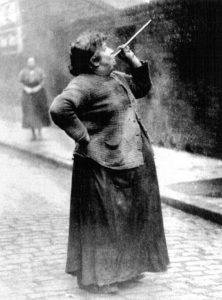 For those of us who have to set an alarm to get up for work, or whatever else one might need an alarm for, the alarm clock truly is not our friend. Whether you had a good night’s sleep or not, really doesn’t matter either. You also know that if the power goes off, or you just don’t happen to hear that alarm, because you are a heavy sleeper…well, you’re going to be late, and your boss is not going to be happy. That alarm going off is always annoying. Nevertheless, we have somewhere we need to be, so that incessant, obnoxious, blaring alarm is a necessity.
For those of us who have to set an alarm to get up for work, or whatever else one might need an alarm for, the alarm clock truly is not our friend. Whether you had a good night’s sleep or not, really doesn’t matter either. You also know that if the power goes off, or you just don’t happen to hear that alarm, because you are a heavy sleeper…well, you’re going to be late, and your boss is not going to be happy. That alarm going off is always annoying. Nevertheless, we have somewhere we need to be, so that incessant, obnoxious, blaring alarm is a necessity.
So, what did people do before alarm clocks? They still had to be to work on time, but if they were a person who did not wake up at the crack of dawn, or to the rooster crowing, what then? Now imagine that your only alarm clock is the sun. If your room is dark, you could have a big problem. Well, there was a fix for that. During the early days of the Industrial Revolution and lasting into the beginnings of the 20th Century, as late as the 1920’s, workers had to get to work on time, and there were no alarm clocks. That’s where the “Knocker-Up” or “Knocker-Upper” came in. Don’t laugh, it was a real occupation in England and Ireland in the days before alarm clocks were affordable or reliable. A Knocker-up’s whole job was to go to the homes of the workers, and wake them up by shooting a pebble through a long tube, usually made of bamboo, and hitting the window pane to wake them up. Some used a long stick, and I can see that it might be helpful if the client was a particularly heavy sleeper. A few whacks on the window sill would wake most people up. The knocker-upper was required to stay outside the house and continue this action until the worker came to the window to show that they were up and would not go back to sleep. In return for their services, the knocker-up’s clients paid them a few pence a week. Not a high paying job for sure. The knocker-ups were usually elderly men and women, or sometimes even the police, because it was a way to supplement their income, as they could do it on their morning patrols. 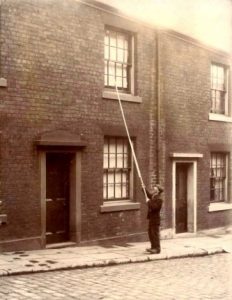
As alarm clocks became readily available, the knocker-ups were no longer needed. Nevertheless, like many other occupations of old, that no longer exist, these have their origins deeply rooted in history when people worked many varying trades and had to improvise to accomplish their tasks. Some of these professions are not what historians or genealogists consider to be mainstream work, but they are a rather interesting thing to look back on. I think it would be odd to have such a strange occupation, but I can see that it was necessary, and it wouldn’t require much time out of your day. Still, one question remains for me. Who was supposed to wake up the knocker-up? They would obviously have to be awake before the others needed to be, and if they were like me, getting me up early is not in anyone’s best interest…just ask my husband, if he should wake me up before the alarm goes off. While this may have been an honorable occupation in those days, I think it would not have been the occupation for me.
 Once a year, on March 17th, the world takes a day to celebrate the wearin’ o’ the green. Saint Patrick’s Day, is really just one of the more fun holidays, that for most of us means nothing more than pinching ayone caught not wearing green, eating corned beef and cabbage, or drinking green beer and celebrating with our friends.
Once a year, on March 17th, the world takes a day to celebrate the wearin’ o’ the green. Saint Patrick’s Day, is really just one of the more fun holidays, that for most of us means nothing more than pinching ayone caught not wearing green, eating corned beef and cabbage, or drinking green beer and celebrating with our friends.
If we lived in Ireland, the day would be very different. That is because in Ireland, Saint Patrick’s Day is a day to celebrate Saint Patrick, who was the patron saint of Ireland. Saint Patrick lived in Ireland in the late fourth and early fifth centuries, but he wasn’t Irish. He was was a Romano-Briton who was captured by Irish raiders and taken to  Ireland as a slave. Saint Patrick was the kind of man who, made lemonaid out of the lemons he found himself with. While he was enslaved in Ireland, he made it his goal to become a missionary there, and he is credited with bringing Christianity to the country, as a result. In Ireland, that makes the holiday a religious holiday, similar to Christmas and Easter. These days you can find Saint Patrick’s Day parades, shamrocks, and green Guinness beer in Ireland, but it’s mostly there for the tourists who think that is the right way to celebrate the day. For most of the Irish, however it would not be that way, and in fact, up until 1970 Irish laws mandated that pubs be closed on Saint Patrick’s Day. That is a stark contrast to the way the day is celebrated here, but it doesn’t mean the same thing to Americans.
Ireland as a slave. Saint Patrick was the kind of man who, made lemonaid out of the lemons he found himself with. While he was enslaved in Ireland, he made it his goal to become a missionary there, and he is credited with bringing Christianity to the country, as a result. In Ireland, that makes the holiday a religious holiday, similar to Christmas and Easter. These days you can find Saint Patrick’s Day parades, shamrocks, and green Guinness beer in Ireland, but it’s mostly there for the tourists who think that is the right way to celebrate the day. For most of the Irish, however it would not be that way, and in fact, up until 1970 Irish laws mandated that pubs be closed on Saint Patrick’s Day. That is a stark contrast to the way the day is celebrated here, but it doesn’t mean the same thing to Americans.
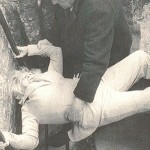
Like many people, I like to eat corned beef and cabbage and pinch those unsuspecting people who have forgotten their green, and while I don’t drink beer…green or otherwise, I like to have fun with the day. But, I also like to reflect a little bit on my Irish roots. I have several parts of my family who came from Ireland, including my Grandma Byer’s family. She wanted to get in touch with her Irish roots too, and so she and her siblings took a trip back to the old country, where they saw the castles, and cemeteries, kissed the Blarney Stone, and visited all the other sites, and I believe they met some of the family who still lives there too. It wasn’t Saint Patrick’s Day when she went, but they really had a good time.
 I am a bit of a forensics buff. Not that I perform the tests that forensic scientists do, I just like watching shows that tell about those tests, and then I try to guess who did the crime. I don’t suppose that I would be the kind of person an innocent man would want to be performing the tests that were going to keep him out…or land him in prison. For an innocent man or woman, being accused of that crime is the beginning of a nightmare. No one wants to believe him, because everybody claims to be innocent…right? Unfortunately, many people accused of crimes are innocent, and in days gone by…before things like DNA matching and fingerprints, the only evidence available was eye witnesses and circumstantial evidence, both of which were far from infallible. Eye witnesses are notoriously unreliable, and it isn’t really their fault, because they were, after all, shook up!!
I am a bit of a forensics buff. Not that I perform the tests that forensic scientists do, I just like watching shows that tell about those tests, and then I try to guess who did the crime. I don’t suppose that I would be the kind of person an innocent man would want to be performing the tests that were going to keep him out…or land him in prison. For an innocent man or woman, being accused of that crime is the beginning of a nightmare. No one wants to believe him, because everybody claims to be innocent…right? Unfortunately, many people accused of crimes are innocent, and in days gone by…before things like DNA matching and fingerprints, the only evidence available was eye witnesses and circumstantial evidence, both of which were far from infallible. Eye witnesses are notoriously unreliable, and it isn’t really their fault, because they were, after all, shook up!!
After spending years in prison, at least fifty people have been exonerated since the dawning of DNA testing. it’s probably hard to say how many have been proven innocent based of fingerprint evidence. And I have to wonder how many have died innocently in prison because they were convicted long before the tests that might have set them free. Fingerprint identification has been used for over a hundred years now, and at one time was considered the best way to prove innocence or guilt. Of course, they aren’t infallible in that respect, because while no two fingerprints have been found to be alike in all those years, it is entirely possible for someone to be somewhere, but not at the time of a crime. If all you have to go on is fingerprints, that can be incriminating…even for an innocent person. Unfortunately, it was not foolproof.

In April of 1953, Watson and Crick published a model of the DNA helix in a one page letter to ‘Nature’. It began with the now famous under statement: “We wish to suggest a structure for the salt of Deoxyribose Nucleic Acid (D.N.A.). This structure has novel features which are of considerable biological interest.” It would take until 1984 before Alec Jefferies and his colleagues would develop genetic fingerprinting, which is using DNA to identify individuals. Finally in 1987 in the United Kingdom, forensic investigators used DNA testing to help solve the ‘Black Pad’ murders and to identify the killer as Colin Pitchfork, who later confessed to the crimes. This was the first case in which DNA evidence is used to determine the identity of a murderer and it also involved a mass screen. It also marks the first case in which a prime suspect was exonerated due to DNA evidence. In 1994 DNA evidence was used in Ireland, and by the 1995 trial of OJ Simpson, it was finally used in America. It seems very strange to me to think that DNA evidence has only been used in the United States for twenty years. To me, it seems like it has been around for a really long time, but that really isn’t so. Nevertheless, on June 28, 1993 DNA evidence cleared Kirk Bloodsworth, an ex-Marine, of a murder for which he had been convicted on this day, July 24, 1984. Sadly, he served nine years before his case was reviewed and he was finally set free.
 Going through our parent’s kitchen was, for me, one of the more interesting parts of going through their house. Mom has had a salt and pepper shaker collection since her childhood, and while we have only scratched the surface of that collection, we have started to draw for them. As we have done so, I have noticed the differences in our personal tastes. We might set out five different sets of salt and pepper shakers, and we would almost always choose a different one for each. For me, a set that Grandma Byer brought back from Ireland for Mom had always caught my eye. They were castles with shamrocks on them, and so typically Ireland. They always seemed so special. Mom’s salt and pepper shakers were a part of who she was.
Going through our parent’s kitchen was, for me, one of the more interesting parts of going through their house. Mom has had a salt and pepper shaker collection since her childhood, and while we have only scratched the surface of that collection, we have started to draw for them. As we have done so, I have noticed the differences in our personal tastes. We might set out five different sets of salt and pepper shakers, and we would almost always choose a different one for each. For me, a set that Grandma Byer brought back from Ireland for Mom had always caught my eye. They were castles with shamrocks on them, and so typically Ireland. They always seemed so special. Mom’s salt and pepper shakers were a part of who she was.
For some reason, many people are collectors. The collections vary as much as the people who collect them. I  know that there are people who don’t collect things, and I suppose their houses are not as cluttered as those of us who do collect things, but somehow I think that maybe they miss out of something that comes with collecting. When you have a collection, you find yourself picking out things of varying styles, as your personal styles change. That is the interesting thing about collecting. Your choices never stay similar. Even with my own collection…spoons, I was able to find interesting styles that were different than any others I had.
know that there are people who don’t collect things, and I suppose their houses are not as cluttered as those of us who do collect things, but somehow I think that maybe they miss out of something that comes with collecting. When you have a collection, you find yourself picking out things of varying styles, as your personal styles change. That is the interesting thing about collecting. Your choices never stay similar. Even with my own collection…spoons, I was able to find interesting styles that were different than any others I had.
And if you think men can’t be collectors, you would be wrong. My dad loved his coffee cups, and Mom even liked the coffee cups, so much so in fact, that before long they had matching sets of cups. There were the Spencer cups, the Al cups, and cups from  the many places they had visited over the years. They even had a tiny cup with a mouse and cheese on it. I guess everyone needed a cup…no matter who they were.
the many places they had visited over the years. They even had a tiny cup with a mouse and cheese on it. I guess everyone needed a cup…no matter who they were.
I don’t know how Dad came to have his collection, but as I said, Mom’s started as a child and her feelings about salt and pepper shakers never changed after that. They would always hold an interest for Mom. As we have looked through the salt and pepper shakers we have come across, we can all see out mother, and we can understand why she found each one that she chose, and each one that was given to her special in its own way. I suppose Mom was more of a collector than Dad was, but as I said, I don’t think anyone is really immune to collecting.
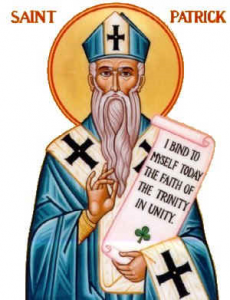 Many holidays get their start on the birth or death of someone famous or very special, and Saint Patrick’s Day is no exception. It was the day that Saint Patrick died in Saul, Ireland. I’m sure that wasn’t surprising to anyone. So, the question then becomes, who was Saint Patrick, and why is he being honored?
Many holidays get their start on the birth or death of someone famous or very special, and Saint Patrick’s Day is no exception. It was the day that Saint Patrick died in Saul, Ireland. I’m sure that wasn’t surprising to anyone. So, the question then becomes, who was Saint Patrick, and why is he being honored?
Saint Patrick was a Christian missionary, bishop, and apostle of Ireland, but that in and of itself was not what made him famous. He lived in a time in history when little would be known of a person’s life if no one took the time to write things down. The Internet, Facebook, and Twitter were far off in the very distant future, so people wrote letters and kept journals. Saint Patrick wrote a book that he titled, “Confessio”, during his last year of life, and it is from these writings that we know what we know of him.
Saint Patrick was born in Great Britain probably in Scotland, to a wealthy Christian family of Roman citizenship. At the age of about 16 years, he was captured be Irish marauders and made to be a slave. For the next six years he worked as a herder in Ireland. Due to the long lonely days, far from family and other human companionship, he drew closer and closer to God for comfort. After hearing a voice in a  dream one night, he escaped and found passage on a ship that took him back to Great Britain and his family. Once he was back with his family, he had another dream. In the dream someone named Victoricus gave him a letter entitled “The Voice of the Irish.” He felt like the Irishmen were pleading with him to go back to Ireland.
dream one night, he escaped and found passage on a ship that took him back to Great Britain and his family. Once he was back with his family, he had another dream. In the dream someone named Victoricus gave him a letter entitled “The Voice of the Irish.” He felt like the Irishmen were pleading with him to go back to Ireland.
In 433, he returned to Ireland, after studying to become an ordained Christian minister and started preaching the Gospel. Thousands of Irishmen were converted to Christianity and many churches were built all around Ireland. After 40 years of devoting his life to God and His work, Saint Patrick died on March 17, 461, in the town of Saul, Ireland, which is where he built his first church.
Since his passing, many legends have grown up about him. He was made the patron saint of Ireland, and  people say that he baptised hundreds of people in a single day. He is also said to have used a three-leaf clover, which became the famous shamrock to describe the Holy Trinity. He is portrayed as trampling snakes because it is said that he had driven them out of Ireland. The Irish observe the day of his passing as a national holiday, attending church in the mornig and celebrating with food and drink in the afternoon. Later the rest of the world jumped on board, and the first Saint Patrick’s Day parade was celebrated in the United States, and involved Irish soldiers serving in the English military marching through the streets of New York City in 1762. The parades became a show of unity and strength for the Irish-American immigrants and the party went global in 1995 when the Irish government started a campaign to matket Saint Patrick’s Day as a way of driving tourists to Ireland. Today, March 17th is still celebrated by millions of people, many of whom probably have no idea what this man stood for. It’s something to think about for sure. Happy Saint Patrick’s Day!!
people say that he baptised hundreds of people in a single day. He is also said to have used a three-leaf clover, which became the famous shamrock to describe the Holy Trinity. He is portrayed as trampling snakes because it is said that he had driven them out of Ireland. The Irish observe the day of his passing as a national holiday, attending church in the mornig and celebrating with food and drink in the afternoon. Later the rest of the world jumped on board, and the first Saint Patrick’s Day parade was celebrated in the United States, and involved Irish soldiers serving in the English military marching through the streets of New York City in 1762. The parades became a show of unity and strength for the Irish-American immigrants and the party went global in 1995 when the Irish government started a campaign to matket Saint Patrick’s Day as a way of driving tourists to Ireland. Today, March 17th is still celebrated by millions of people, many of whom probably have no idea what this man stood for. It’s something to think about for sure. Happy Saint Patrick’s Day!!
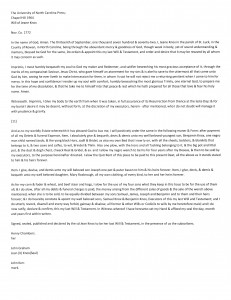 When I think of my husband, Bob’s 6th great grandmother, Jean Gracy Knox, I always think of Ellen O’Hara…Scarlett O’Hara’s mother, in Gone With The Wind. They lived in different eras, but in many ways, their lives were much the same. I can’t say, for certain, that Jean Knox lived on a plantation, but I do know that like many people in the 1700’s she owned slaves. With that in mind, I have to assume that she ran their home or plantation in much the way that Ellen O’Hara had. I don’t know much about her, of course, but her will seemed to be written by a woman who was used to being in charge. I know that she was a slave owner, because in her will, she mentions what is to be done with a young slave boy and a female slave that she owned. That and the extensive collection of clothing that she left her daughter, Mary indicates that she was a woman of wealth.
When I think of my husband, Bob’s 6th great grandmother, Jean Gracy Knox, I always think of Ellen O’Hara…Scarlett O’Hara’s mother, in Gone With The Wind. They lived in different eras, but in many ways, their lives were much the same. I can’t say, for certain, that Jean Knox lived on a plantation, but I do know that like many people in the 1700’s she owned slaves. With that in mind, I have to assume that she ran their home or plantation in much the way that Ellen O’Hara had. I don’t know much about her, of course, but her will seemed to be written by a woman who was used to being in charge. I know that she was a slave owner, because in her will, she mentions what is to be done with a young slave boy and a female slave that she owned. That and the extensive collection of clothing that she left her daughter, Mary indicates that she was a woman of wealth.
It’s possible that her “take charge” attitude came from the fact that her husband passed away fourteen years before she did, and six months before their youngest child was born. She had no choice but to take charge of things. She still had five children under the age of sixteen in her home. I’m certain that her older sons helped her out too, but from what I have gathered from her will, she was very much in control of her life, children, and property. I wish I had a picture of her, but in my mind, she probably looked much like Ellen O’Hara did, in Gone With The Wind. Beautiful, and very ladylike, and yet, she ran the household and even helped out the neighbors when necessary. Of course, I could be wrong on all that, but from what I have read of her will, she knew exactly what she wanted done after her passing. The will appears to have been written just days before her death. They assumed this from the fact that she made her mark on it, and not her signature, even though she could read and write. In looking at the will, of which I only have a word for word copy of the wording as it was written…including all the spelling errors, I at first thought that maybe she couldn’t read and write, but later discovered that it was not written by her. She just dictated it to someone else to write up and then signed it in front of witnesses, much like we would do today in front of a attorney. This could also have been an indication of wealth, and the power that one assumes to have because of it.
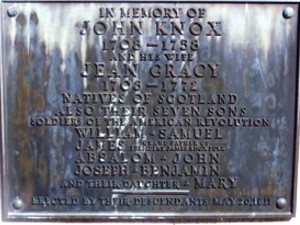
I also know, that Jean was a woman of strong faith. She was a Presbyterian, and most likely left her native Ireland because of disputes between the Presbyterians, also known as Covenanters, and the Church of England. The Knox family is among those who were persecuted because of their religion, and that some had to leave their homes in the middle of the night to escape death. They came to America seeking religious freedom. That in itself would take a person of strong character, and may have been part of what made Jean Gracy Knox into a woman who was well able to handle the things that came her way. Jean’s life was not long, by today’s standards anyway, but in that day and age, she did live a long time, and it is my opinion that she also did a lot of living during her lifetime. I’m sure that I will never really know the whole story of her life, but I will always believe that she was quite a lady.

